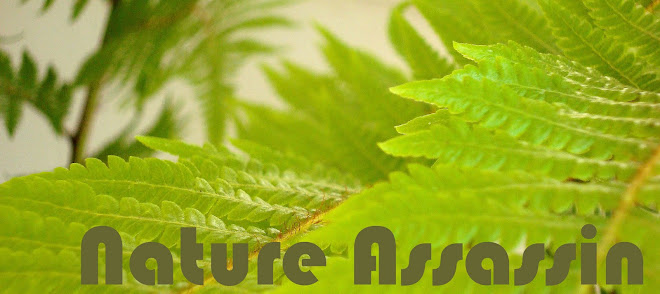In recent weeks I have successfully killed TWO specimens of brake fern (RIP, pteris ensiformis), a fittonia "White Anne," and a pilea "Moon Valley." These achievements are trifles, however, in comparison to the assassination I am featuring today.
I hereby declare victory over a notorious foe:
the mealybug.
In 2007 I acquired a superb-looking strelitzia, a.k.a. Bird of Paradise plant. I had no understanding at the time, but I was also acquiring a small army of legless, wingless, headless rogues. The mealybugs had colonized the rootball of the plant very discreetly, and it was weeks before the first brave soldier migrated north. Upon discovering the first mealy, I assumed it was a piece of fuzz. However, a piece of fuzz does not pop and turn into a small puddle of blood and goo when it is picked up. Thus occurred the first casualty of a long battle between two nature assassins: the mealybug and myself. I come before you now with hard-won knowledge, to help you treat your own mealy problems.
Step One: Identifying the Enemy

Mealies are small, white, furry insects that look like bits of cotton. The females move, but very slowly and only amongst plants, so don't worry about getting mealybugs in your hair or anything. The males are rarely seen and eat nothing because they have no mouth. Like, literally, no mouth-parts at all. For this reason they don't live very long. Gross, right? I know. Mealies love to nestle in the crevices between a stem/rachis and a leaf/pinnule, where they can suck the life force from your plants in quiet seclusion. For this reason, it is always a good idea to do a monthly check of the undersides of plant leaves, and the bottoms of your pots. Monthly or weekly cleaning of your houseplants with a gentle stream of water or a moist cloth will often provide all of the prevention you need. Furthermore, mealies are attracted to weakened plants the way vultures are attracted to lost and thirsty travelers, so keep an eye on your pot-bound, over-fertilized, poorly-lit, or generally sickly specimens. Once mealies are identified on a plant, keep the plant isolated. If you can see more than ten or twenty mealies on a house specimen, seriously consider throwing the plant away. If you have a special attachment to the plant or have an aversion to plant murder, move on to step two.
Step Two: Give them the proverbial "What-For"
Warning: Graphic Imagery of a Nature Assassination Ahead

Take a cotton swab soaked in alcohol, and remove as many of the mealies as you can. Smash them, rejoicing in the gory riptide of battle as you do so (optional), and throw them away. Repeat this step once a week or more until their numbers are diminished and finally extinguished. Do not resort to scary sprays or systemic insecticides, I beg you. You will probably end up killing your plant, I don't care what the nice man at Home Depot tells you.
Step Three: If all else fails, try this. Take your plant to the garbage, and gently remove it from its pot. Throw the pot away. Gently tease the roots out and try to remove as much of the soil as possible. Wash the whole plant in gently running water, removing the rest of the soil from the rootball with the stream. It will look naked and pathetic, if you do it thoroughly. Finally, repot the plant in fresh sterilized potting soil and place it somewhere that it will receive bright but NOT direct sunlight. Continue to check for remaining mealies. After one pest-free month, your happy plant can be reintroduced to the collective. It worked for me: my strelitzia is looking better than ever.
And that, friend, is how you ace a mealybug.












